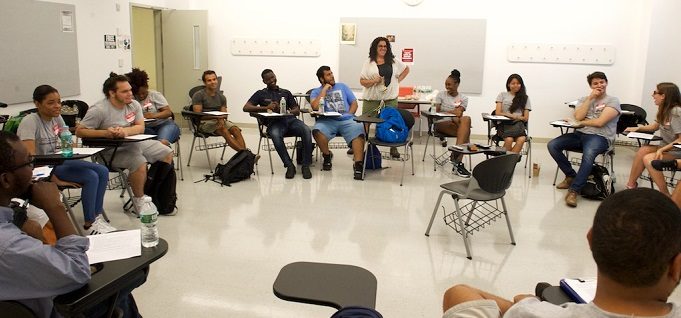Endorsing OER
By Brenda Vollman and Michelle Ronda
November 14, 2017
Two faculty members have seen transformative benefits of OER.
Borough of Manhattan Community College (BMCC) faculty have been working with the college’s library to transition course materials from expensive, tightly-licensed, traditional textbooks into open educational resources (OER), which are freely accessible documents and media.
The effort at BMCC is the largest and most consistent OER program throughout the City University of New York (CUNY) system. The effort is being funded by state funds and foundation grants.
As faculty members, our primary goal in moving to OER has been to break down the prohibitive costs of classroom materials. But OER also frees us of the legal restrictions of licensing materials and instead, prioritizes a commitment to creativity and faculty participation in developing quality classroom materials for all.
In Spring 2016, faculty from the criminal justice program committed to developing OER for all six courses in the major, ranging from Introduction to Criminal Justice to Crime and Justice in Urban Communities.
That semester, we trained extensively with Jean Amaral, BMCC’s open knowledge librarian, in four workshops that introduced us to Creative Commons licensing, the use of materials with copyright restrictions, and we learned how best to search for materials that have less restrictive or fully-open copyright, and then, how best to share those materials with students in our courses — whether it be through Blackboard, or by creating our own Word Press sites.
We shared our work through a Google spreadsheet, crafting content headings, including hyperlinks to the materials we selected. Throughout the process, we’ve discovered that there is flexibility in crafting courses while delivering content that both meets and, in many cases, strengthens a course’s learning objectives, all the while staying current in our respective disciplines.
We have since been able to share these “course shells” with other faculty interested in using OER in their criminal justice courses. Each of us has also developed assignments, quizzes and/or exams based on these new materials. Many of us crafted PowerPoint slides to accompany the materials.
Unexpected benefits
Although the main goal in participating in the OER effort was to lower costs for students, we’ve also seen unexpected benefits. Not only did students gain access to materials more quickly than they would while waiting for financial aid to cover the cost of textbooks, they engaged more closely with the materials, since they can access them from anywhere.
We found the process energizing and exciting: being freed from the confines of a textbook reawakened our creativity in how we wanted to teach the course. It has given us the chance to learn from our peers.
We’ve used the new, easily-accessed materials to get students excited and thinking more critically about our specific disciplines. The process of moving to open and alternatively-sourced educational materials also encouraged faculty to expand their thinking as scholars and teachers, and take full advantage of the plethora of information in the ever-changing, digitally-driven world we live in.
Put simply, moving to open sourced materials has reignited our passions for investigating and it has entirely changed — dare we say, revolutionized — the way that we think about our place as professors in creating, vetting and engaging with information, both within and outside criminology and criminal justice.
And at the core of this effort, we are beginning to understand the financial impact OER is having on many of our students — a large proportion of whom come from economically-challenged backgrounds.
Estimates show that more than half of CUNY students come from households with annual incomes of less than $20,000. For many students, including those at BMCC, the average $1,200 cost each year for books and other supplies can be a barrier to academic success.
By spring 2017, BMCC faculty were teaching approximately 175 sections of zero-textbook-cost courses, which resulted in an estimated savings of $450,000 for more than 4,000 students. By the end of the fall 2017 semester, cumulative savings for BMCC students will be almost $1 million.
With that said, community college teaching and learning is teaching and learning, and it is learning that we are responsible for. Educational justice is not bankrupt. The buck stops here.




